By Philip Cauchi
In this session we identify how through securing possession we can play through the opponents’ defence. We start our plan by asking ourselves structured questions which will guide us on designing the training session. The same questions can be asked to the players so that they themselves arrive to the solutions of what is required from them in the game.
Session title: Principles of securing the ball to penetrate.
Total duration: Approximately 90 minutes.
Moment of play: In possession.
Team task: Build-up.
Theme: Attack construction in midfield.
Aim: To secure possession and recognise the right moment of when to penetrate.
Macro-principles of play: Support, penetration, width and depth.
Questions on which the outcomes of the session are based:
Q1 – What is the ultimate intention of our team when in possession?
A1 – To find the right moment to play the ball into dangerous areas and create a goal-scoring opportunity.
Q2 – What if penetration is hard to achieve due to the discipline and compactness of our opponents?
A2 – We secure possession of the ball.
Q3 – Why do we keep possession of the ball?
A3 – We circulate the ball to move the opponents and create gaps between them through which we can play vertical passes.
Q4 – Where on the field does this happen?
A4 – Midfield third.
Q5 – How can we keep possession?
A5 – By overloading the area around the ball, create passing angles as well as have width, length and depth.
Q6 – Who are the main players involved?
A6 – Practically the whole team is involved. However, the majority of the load is put on the midfield sector who act as the engine of the team. The full backs also play a key role by providing width, while the striker provides length and the central defenders provide depth.
Sub-principles (group outcomes): Striker to provide length, 7 and 11 to move into the half spaces and attack the spaces between the lines, midfielders 6, 8 and 10 create the necessary angles and options, full backs 2 and 3 to provide width, and central defenders 4 and 5 to provide support and depth.
Sub-Sub-principles (individual outcomes): Spatial awareness, positioning, stance, oriented control and quality of passes.
In this session we emphasize the positioning and movement of the three midfielders 6, 8 and 10.
Equipment: Markers, bibs, mini goals, cones and balls.
Warm-up – technical-tactical activation.
Practice 1 – Passing through the gates.
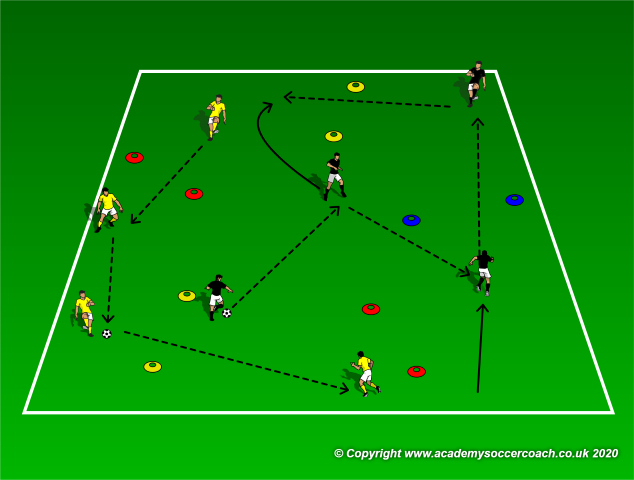
N.B. Prior to this activity carry out a 7 minute movement preparation session that includes dynamic flexibility and mobility.
Duration: 10 minutes.
Aim: To prepare the players on recognizing and moving into the correct space and time to receive the ball using an open body stance and play quick passes on the ground.
Set-up: Have two setups of eight players each. Each setup has an area measuring approximately 15 yards by 12 yards. In each setup the players are further divided into two groups of four players. Each group has a ball (see the illustration of practice 1).
Description of practice:
Variation 1 – Players dribble and pass the ball to each other through the gates. After passing through a gate, the player on the ball must dribble towards another gate. The black and yellow teams must not pass the ball through the same gate simultaneously.
Variation 2 – Same as in variation 1 but the players pass the ball with one touch and every time they pass through a gate they earn a point. Play competitively in series of one minute.
Variation 3 – Same as in variation 2 but now the players in each group are numbered from 1 to 4. The passes must be played in sequential order. Player 1 passes to player 2, player 2 passes to player 3, player 3 passes to player 4 and player 4 passes to player 1.
Practice 2 – 3v3+2 score through the gates.
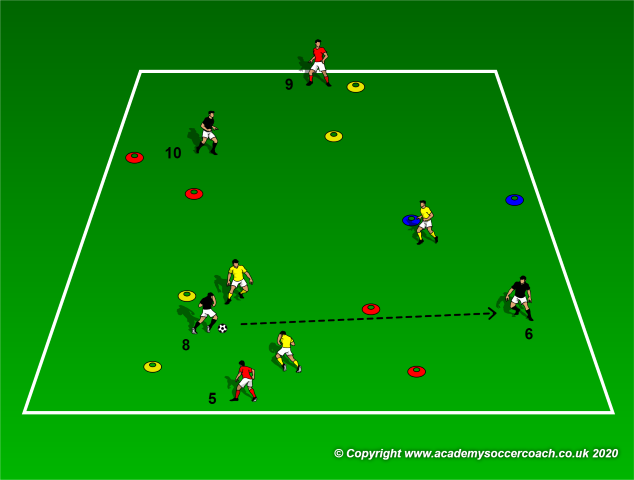
Duration: 10 minutes (play in series of 2 minutes with dynamic flexibility in between).
Aim: To circulate the ball while moving and maintaining a good shape in midfield.
Set-up: Have two setups of eight players each. Each setup is assigned an area measuring approximately 15 yards by 12 yards. Play 3v3+2 neutrals in both setups. In the setup shown in practice 2 we work on ball circulation in midfield, while in another we work on the right and left chains and how players combine with others in the same sector to keep the ball in order to construct an organised attack. In the latter we may use goalkeepers as neutrals.
Description of practice: Both teams aim to score by passing the ball through the gates. Teams may not score in the same gate twice in succession.
Key-performing outcomes: Spatial awareness, angles, off-the-ball movement, stance, oriented first touch, quality of passes to circulate the ball at speed and the attitude to play vertical whenever possible.
Main part.
Practice 3: 3v3+2 play to the target player.
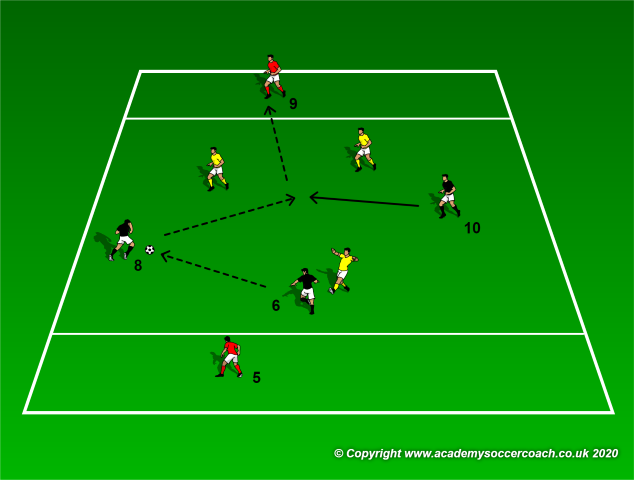
Duration: 10 minutes (4 series x 2 minutes with 2 minutes of recovery between series).
Aim: To recognise the right moment when to play vertically and penetrate.
Set-up: Area measuring 20 yards by 15 yards with an additional three meter end zone at both ends. Three players in each team and a neutral in each end zone.
Description of practice: Both teams defend an end zone and attack the opposite. Teams may use the neutral player inside the end zone they are defending to keep possession. In the example in practice 3 (above image) the blacks are attacking and the red number five in this case is the central defender with whom the blacks may play to retain the ball. The below diagram is the same exercise but played by the lateral chains of the team. The black team is the right sided chain, while the yellow team is the left sided chain.
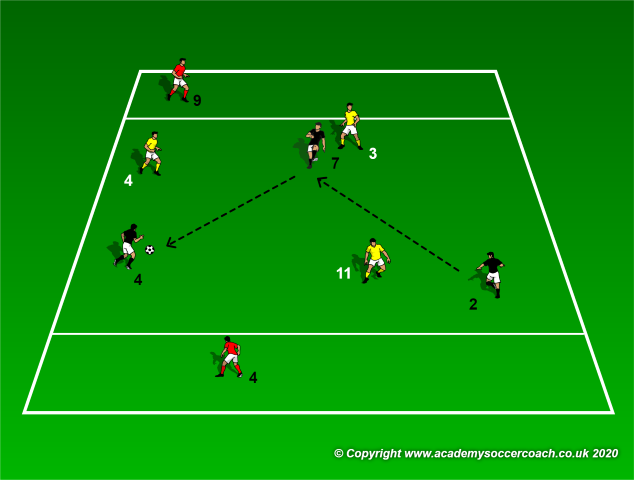
Key-performing outcomes: Passing angles, stance, oriented first touch, quality of passes, and movement off-the-ball. This applies especially by the neutral players who all the time must move to create a passing lane for the attacking team to either support or play vertically.
Progressions to both practices:
Progression 1: To score, the target player must receive and lay the ball off to a player of the attacking team to dribble across the goal line.
Progression 2: Create two gates with cones on each end line. To score the team in attack must dribble through any of their assigned two gates after the ball was laid off by the target player.
Practice 4: 6v6+4 on six mini goals.
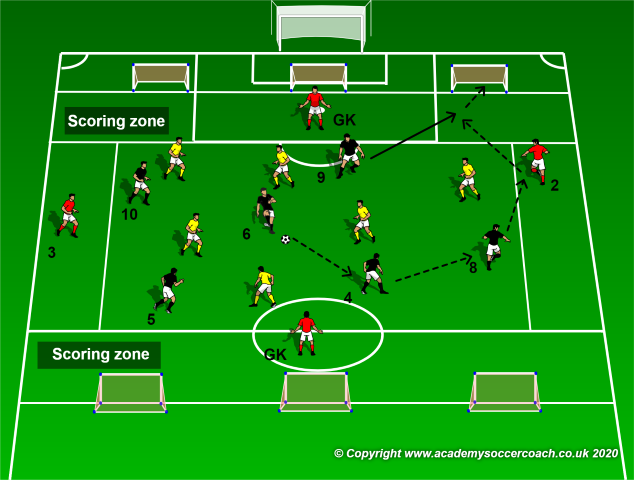
Duration: 12 minutes (Play for 10 minutes then rest for 2).
Aim: Circulate the ball quickly and switch play to attack the defending team’s weaker side.
Set-up: Area measures 35 yards in length by 60 yards in width with an additional 5 yard scoring zone at both ends. There are two teams of six players each and four neutrals of which the two on the flanks are fullbacks and the two in the middle providing depth/length are goalkeepers. Three mini goals are positioned on each end line.
Description of practice: Both teams attack three mini goals and defend the opposite three. No one except the neutral goalkeepers are allowed inside the scoring zone. The neutrals help the attacking team maintain possession of the ball. At first the full backs are allowed to score. Goals must be scored from inside the scoring zone by either having the ball-carrier dribbling the ball into the scoring zone or after a pass which can be played with either a teammate or a neutral player. If the ball goes out of play, restarts take place from the goalkeeper of the team in possession.
Practice 4 – Progression.
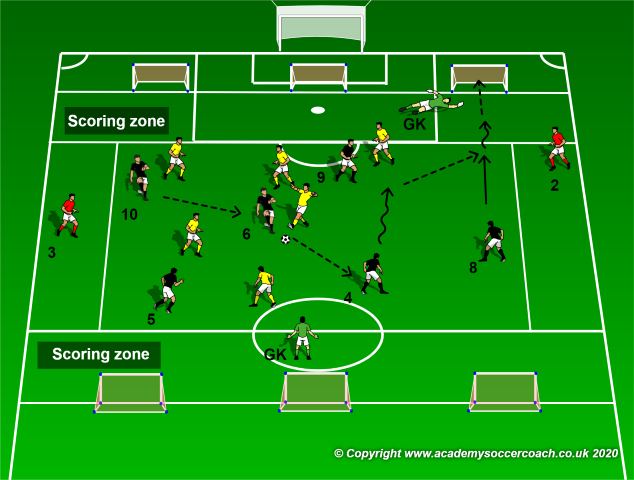
Duration: 12 minutes (Play for 10 minutes then rest for 2).
Aim: Switch the point of attack quickly.
Set-up: Area measures 35 yards by 60 yards with an additional 5 yard scoring zone at both ends. There are two teams composed of six players and a goalkeeper each and two neutral fullbacks on the flanks. Three mini goals are positioned on each end line.
Description of practice: As in the previous practice, however the goalkeepers are not neutrals and aim to protect the three mini goals. Nobody except for the attacker receiving or dribbling the ball and the goalkeeper should be in the scoring zone.
Practice 5: 6+GKv6+GK +2 neutrals through the gates to score.
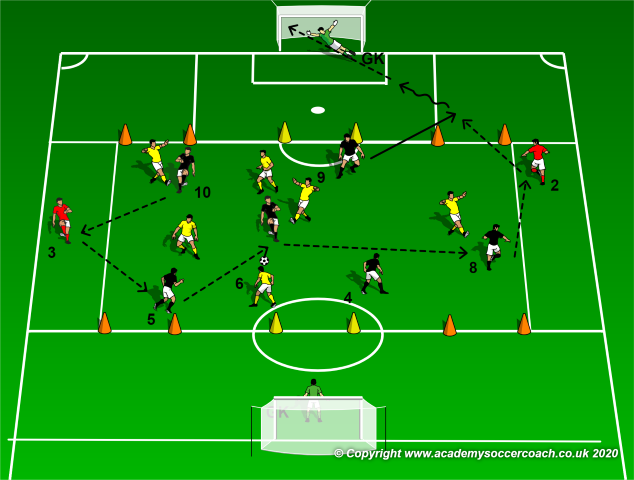
Duration: 22 minutes (2 series x 10 minutes with 2 minutes recovery between series).
Aim: To play accurate quick passes and searching for the right moment to penetrate.
Set-up: 70 yards in length by 60 yards in width. In the middle we have an area measuring 35 yards by 60 yards in which a flank zone on each side is marked. Two teams of six players are positioned inside the middle area, a neutral fullback for each team is positioned at each flank zone and a goalkeeper for each team is positioned in each goal. Three gates are marked on each end line of the middle area.
Description of exercise: Play takes place inside the marked middle area. Goals only count after the player receives a pass through the gates or by dribbling through them. A 1v0 against the goalkeeper is then carried out.
Progression: Remove the gates and play a normal game of 8v8 including goalkeepers.
Conclusion – Cool down.
Light passing followed by static stretching exercises. These should take from 7 to 10 minutes.
By Philip Cauchi


